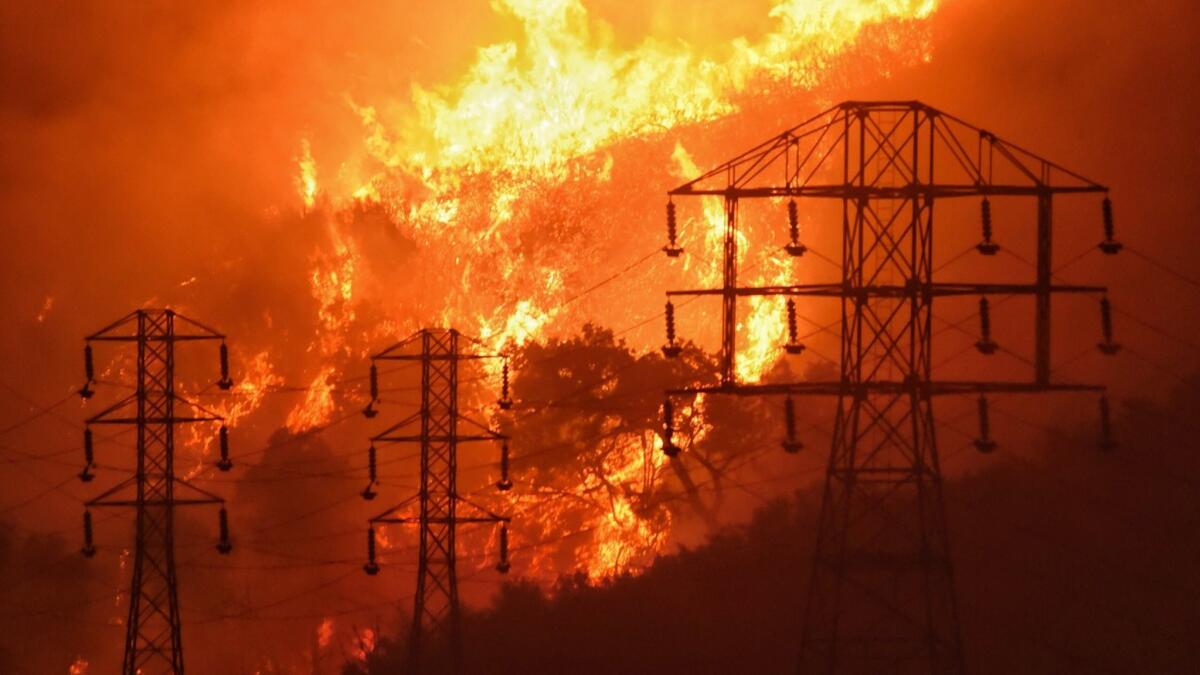Editorial: California’s wildfire commission delivers its reform plan, only to be promptly ignored

- Share via
The five members of the Commission on Catastrophic Wildfire Cost and Recovery were given no small task: Dive into the highly wonky issues of electric utilities, finance and insurance to come up with a fair and workable plan to spread the cost of future wildfires caused by power lines. And do it without letting power companies off the hook or dumping the entire burden onto ratepayers. And do it in less than six months. With no pay.
To their credit, the commissioners — all respected experts in their various fields — did just that. They spent months traveling across the state to take testimony from the people who lost homes and loved ones in wildfires, as well as from fire experts, utility managers, consumer advocates, lawyers and anyone else with an opinion. They released their report on May 29 calling for a series of urgent and interconnected reforms: doing away with the so-called strict liability standard for utilities, establishing a wildfire victims fund to help people rebuild quickly, and implementing policy changes to stabilize the homeowners insurance market.
And how was their report received? Gov. Gavin Newsom and legislative leaders, to their discredit, announced on the very same day that one of the cornerstones of the recommendations — removing the strict liability standard for utilities and replacing it with a fault-based system — was just not going to happen. At least not this year. Thanks anyhow!
Lawmakers have been wary of tinkering with strict liability because some utility critics have labeled it a bailout for utility shareholders.
It was shockingly disrespectful to immediately dismiss the hard work of the commissioners, who surely had better things to do than sit through hours of testimony, pore over deadly dull documents and produce an admirably comprehensive report that would be ignored. It was also disrespectful to all Californians, who will ultimately pay for inaction.
The strict liability system — called “inverse condemnation” — requires that utilities pay for any damage to private property caused by their equipment, such as power lines, regardless of fault. The idea is that a utility can pay the cost upfront but then socialize the cost among its broad base of ratepayers. The system worked out well enough until recently, when a combination of drought, higher temperatures, aging electrical equipment and growth in high-fire risk areas resulted in massive wildfires, the most destructive of which were mostly ignited by power lines and equipment. This meant huge costs would be forced onto ratepayers (or in the case of investor-owned utilities, onto their shareholders, if regulators determined the utility hadn’t acted prudently).
All this fiscal uncertainty in the face of billions of dollars in claims for fires started by its power lines drove the state’s largest power supplier, Pacific Gas & Electric Co., into bankruptcy this year. And the state’s second- and third-largest power companies have had their credit ratings downgraded, which makes it more expensive for them to borrow money to carry out capital projects such as planned fire prevention upgrades.
The move to reverse inverse condemnation was initiated by the state’s largest power companies, which are owned by investors, but inverse condemnation is potentially a bigger problem for public power utilities, some of which are so small that claims from one big fire could threaten their very existence. That’s the predicament of the tiny Trinity Public Utility District, which serves 7,300 customers over 220 square acres in mountainous Trinity County. It has about $12 million in annual revenue and faces $139 million in claims from the 2017 Helena fire that was started when a tree branch fell on Trinity’s power lines that the district says was outside of its jurisdiction.
But lawmakers have been wary of tinkering with strict liability because some utility critics have labeled it a bailout for utility shareholders. Michael Kahn, a former chairman of the California ISO and Electricity Oversight Board who sits on the catastrophic wildfire commission, insisted during a public meeting June 7 that the commission’s proposal would not let the big investor-owned utilities off the hook. Shareholders would still be required to pay damages for fires caused by negligence.
Enter the Fray: First takes on the news of the minute »
Removing the strict liability standard — and replacing it with a fault-based standard, a wildfire victims fund that could be paid for by tapping a broad base of California residents and businesses (including utilities), and reforms to make sure homeowners have access to insurance — would actually be a bailout for ratepayers. It is a more sustainable and fairer way to deal with future wildfires caused by power lines. This approach would also force local government and residents to consider the cost of building and living in fire-prone areas.
Power ratepayers are already taking on the extra costs of making the safety upgrades the state requires for fire prevention, as well as the investment in renewables required to meet the state’s green energy goals. For them to also pay the cost of wildfire damage that was not started due to negligence, and the potential cost for bankruptcy of the utility, puts too much extra burden on ratepayers.
Lawmakers could have done away with strict liability last year, but instead they created the catastrophic wildfire commission to put off that difficult, but necessary, step. Now they want to put it off for another year. This needs to be solved now, before the next big wildfire.
Follow the Opinion section on Twitter @latimesopinion and Facebook
More to Read
A cure for the common opinion
Get thought-provoking perspectives with our weekly newsletter.
You may occasionally receive promotional content from the Los Angeles Times.









